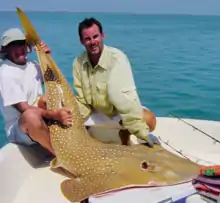African wedgefish
The African wedgefish, guitarra, Lubbert's guitarfish, or spikenose wedgefish (Rhynchobatus luebberti) is a species of fish in the Rhinidae family. It is the only species in its genus to occur in the East Atlantic.[3]
| African wedgefish | |
|---|---|
 | |
| Scientific classification | |
| Domain: | Eukaryota |
| Kingdom: | Animalia |
| Phylum: | Chordata |
| Class: | Chondrichthyes |
| Superorder: | Batoidea |
| Order: | Rhinopristiformes |
| Family: | Rhinidae |
| Genus: | Rhynchobatus |
| Species: | R. luebberti |
| Binomial name | |
| Rhynchobatus luebberti Ehrenbaum, 1915 | |
Etymology
The fish is named in honor of Hans Julius Lübbert (1870-1951), a German fisheries inspector.[4]
Taxonomy
Description
African wedgefish have a pale olive-brown or olive-grey color with white spots spread across their back. The edges of their fins are sometimes paler in color. They have a cluster of three black marks on each side of a ridge that runs along their back. Another dark mark can be found each one of these marks. The area around each fish's eye is lighter, reminiscent of a mask. The fish have ridges near their front that possess a row of thorns.[5]
The African wedgefish has a maximum total length of about 3 m (9.8 ft), but are usually 1.5 m (4.9 ft) long. They have 172-176 free vertebral centra.[6][7]
Distribution and habitat
The fish is found in the warm East Atlantic in Angola, Benin, Cameroon, the Republic of the Congo, the Democratic Republic of the Congo, Ivory Coast, Equatorial Guinea, Gabon, Gambia, Ghana, Guinea, Guinea-Bissau, Liberia, Mauritania, Nigeria, Senegal, Sierra Leone, and Togo.
Its natural habitats are shallow seas, coral reefs, estuarine waters, and coastal saline lagoons.[5]
Diet
The African wedgefish prey upon small bony fish and invertebrates.[5]
Life history
Early life
African wedgefish are ovoviviparous—eggs remain inside the mother until hatching. Embryos initially feed on yolk. Afterward, they receive nutrition from their mother by absorbing uterine fluid that contains mucus, fat, or protein through specialized structures.[7][8]
Conservation
The African wedgefish is currently critically endangered.[6]
Threats
It is threatened by habitat loss and poachers.[5]
References
- Kyne, P.M.; Jabado, R.W. (2019). "Rhynchobatus luebberti". IUCN Red List of Threatened Species. 2019: e.T60180A124448712. doi:10.2305/IUCN.UK.2019-2.RLTS.T60180A124448712.en. Retrieved 14 November 2021.
- "Appendices | CITES". cites.org. Retrieved 2022-01-14.
- Moore, Alec (2017-01-01). "Are guitarfishes the next sawfishes? Extinction risk and an urgent call for conservation action". Endangered Species Research. 34: 75–88. doi:10.3354/esr00830.
- Christopher Scharpf & Kenneth J. Lazara (22 September 2018). "Order RHINOPRISTIFORMES". The ETYFish Project Fish Name Etymology Database. Christopher Scharpf and Kenneth J. Lazara. Retrieved 13 January 2022.
- Marquez, Melissa C. (July 4, 2018). "African wedgefish". The Fins United Initiative. Archived from the original on 2018-11-24. Retrieved 2018-11-24.
- Last, Peter; Naylor, Gavin; Séret, Bernard; White, William; Carvalho, Marcelo de; Stehmann, Matthias (December 2016). Rays of the World. Csiro Publishing. p. 73. ISBN 9780643109148.
- "Rhynchobatus luebberti summary page". FishBase. Retrieved 2018-11-24.
- Dulvy, N. K.; Reynolds, J. D. (1997-09-22). "Evolutionary transitions among egg-laying, live-bearing and maternal inputs in sharks and rays". Proceedings of the Royal Society B: Biological Sciences. 264 (1386): 1309–1315. Bibcode:1997RSPSB.264.1309D. doi:10.1098/rspb.1997.0181. ISSN 0962-8452. PMC 1688595.
